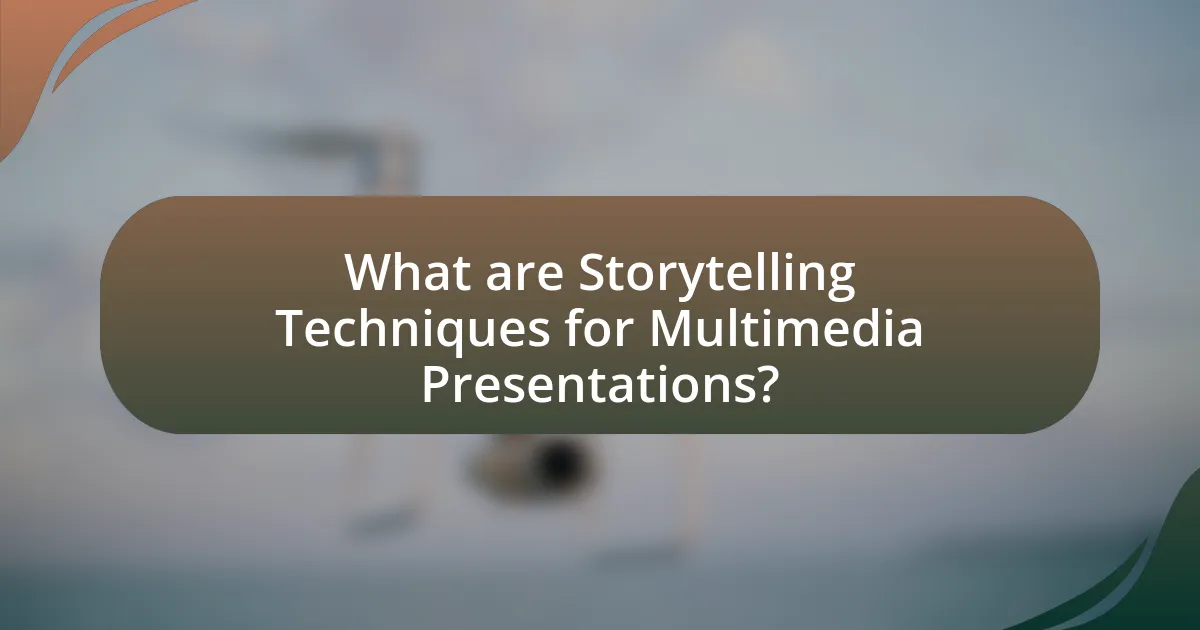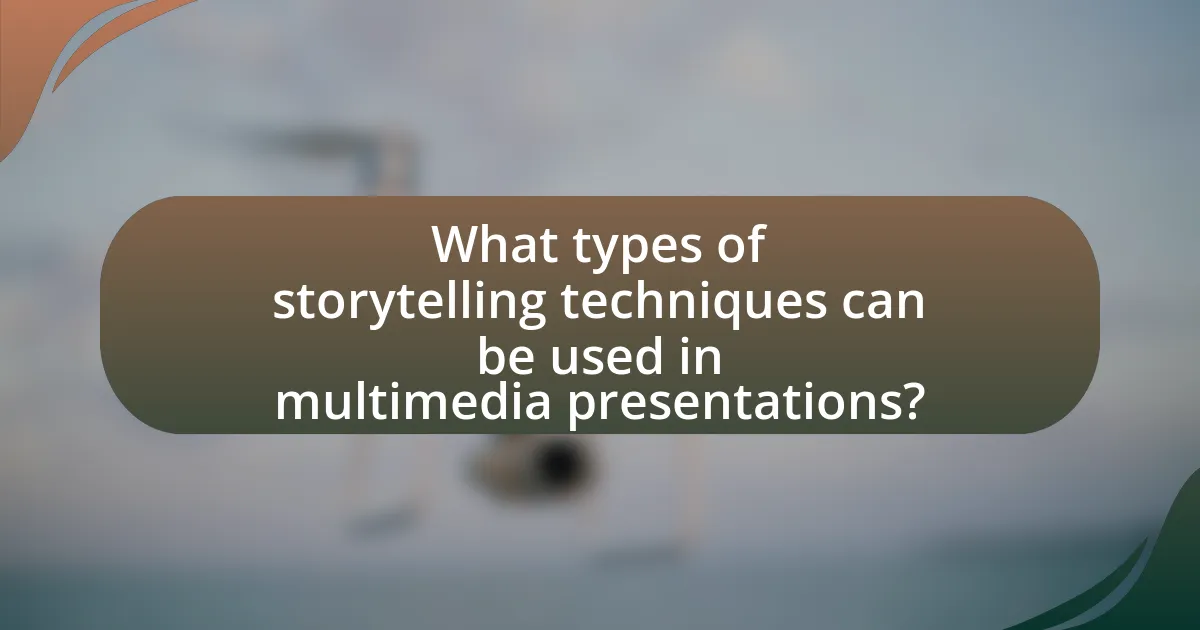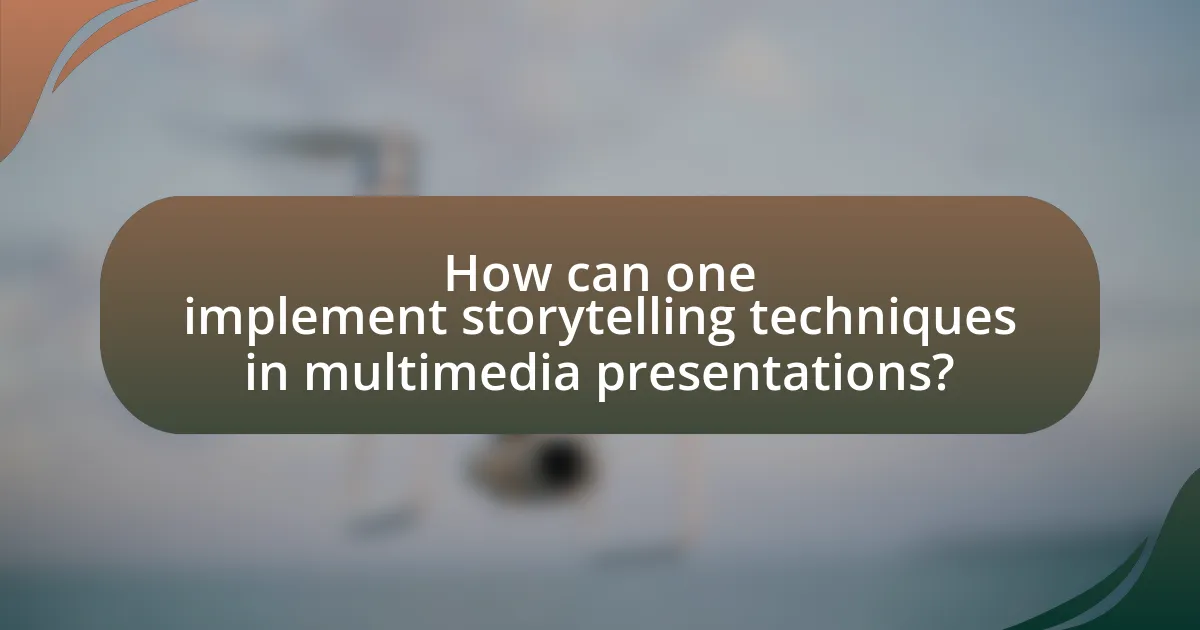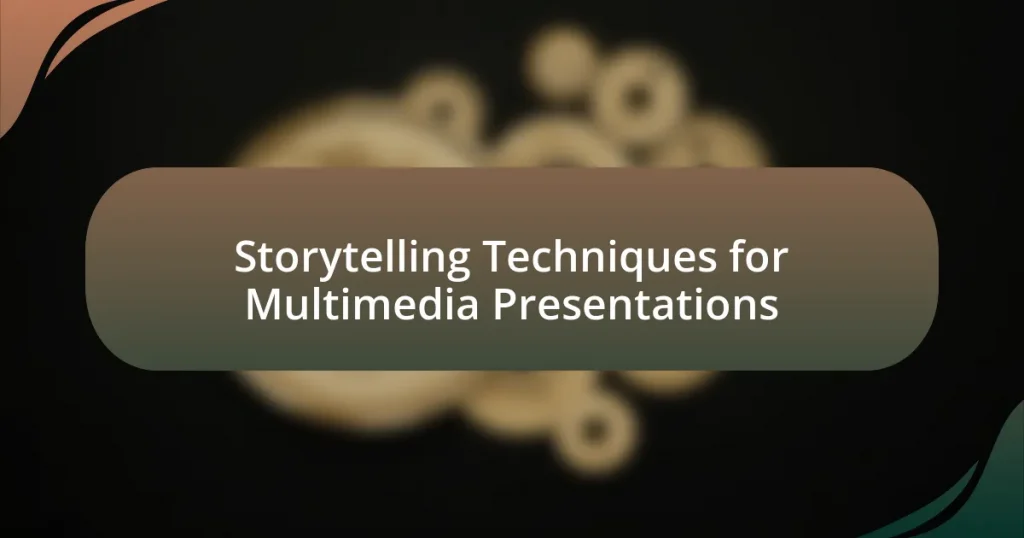The article focuses on storytelling techniques for multimedia presentations, emphasizing the importance of narrative structure, visual storytelling, emotional engagement, and interactivity. It outlines how these techniques enhance audience retention and engagement by creating emotional connections and making complex information relatable. Key elements discussed include the impact of narrative structure on presentation effectiveness, the role of visuals and audio in storytelling, and best practices for integrating these elements to create compelling narratives. Additionally, the article highlights common pitfalls to avoid and practical tips for refining storytelling skills in multimedia contexts.

What are Storytelling Techniques for Multimedia Presentations?
Storytelling techniques for multimedia presentations include the use of narrative structure, visual storytelling, emotional engagement, and interactivity. Narrative structure organizes content into a clear beginning, middle, and end, which helps audiences follow the storyline. Visual storytelling employs images, videos, and graphics to enhance understanding and retention of information, as studies show that visuals can improve recall by up to 65%. Emotional engagement connects the audience to the content, making it more relatable and memorable; research indicates that emotionally charged stories are more likely to be shared and remembered. Lastly, interactivity allows audiences to participate actively, which can increase engagement and comprehension, as interactive elements have been shown to boost learning outcomes significantly.
How do storytelling techniques enhance multimedia presentations?
Storytelling techniques enhance multimedia presentations by creating emotional connections and improving audience engagement. These techniques, such as narrative structure, character development, and visual storytelling, help convey complex information in a relatable manner. For instance, research by the Stanford Graduate School of Business indicates that stories are 22 times more memorable than facts alone, demonstrating the effectiveness of storytelling in retaining audience attention and facilitating understanding. By integrating storytelling elements, presenters can transform data into compelling narratives that resonate with viewers, ultimately leading to more impactful communication.
What elements of storytelling are crucial for engaging an audience?
Crucial elements of storytelling for engaging an audience include a compelling narrative structure, relatable characters, emotional resonance, and vivid imagery. A compelling narrative structure, often characterized by a clear beginning, middle, and end, helps maintain audience interest and provides a logical flow. Relatable characters allow the audience to connect personally, fostering empathy and investment in the story. Emotional resonance engages the audience’s feelings, making the story memorable and impactful. Vivid imagery enhances the storytelling experience by creating mental pictures that captivate the audience’s imagination. Research indicates that stories with these elements are more likely to be remembered and shared, as they tap into fundamental human experiences and emotions.
How does narrative structure impact the effectiveness of a presentation?
Narrative structure significantly enhances the effectiveness of a presentation by providing a coherent framework that guides the audience through the content. A well-defined narrative structure, such as the classic three-act structure, helps in organizing information logically, making it easier for the audience to follow and retain key messages. Research indicates that presentations with a clear narrative arc can increase audience engagement by up to 70%, as it creates emotional connections and facilitates better understanding of complex ideas. This structured approach not only aids in maintaining attention but also improves recall, as stories are inherently more memorable than disjointed facts.
Why is storytelling important in multimedia presentations?
Storytelling is important in multimedia presentations because it enhances audience engagement and retention of information. When narratives are woven into presentations, they create emotional connections, making the content more relatable and memorable. Research indicates that stories can improve information recall by up to 22 times compared to facts alone, as demonstrated in studies by the NeuroLeadership Institute, which found that storytelling activates multiple areas of the brain, leading to better understanding and retention. This effectiveness is crucial in educational and professional settings, where the goal is to convey complex ideas clearly and effectively.
What psychological effects does storytelling have on audience retention?
Storytelling significantly enhances audience retention by engaging emotional and cognitive processes. When narratives are presented, they activate the brain’s mirror neurons, fostering empathy and connection, which makes the content more memorable. Research indicates that stories can improve information recall by up to 22 times compared to non-narrative formats, as demonstrated in a study published in the journal “Cognitive Science” by Paul Zak, which found that storytelling increases oxytocin levels, enhancing emotional engagement and memory retention. This psychological effect underscores the importance of storytelling in multimedia presentations, as it not only captures attention but also facilitates deeper understanding and recall of the material presented.
How can storytelling create emotional connections with the audience?
Storytelling creates emotional connections with the audience by engaging their empathy and imagination through relatable characters and compelling narratives. When audiences identify with characters’ struggles and triumphs, they experience emotions that resonate with their own lives. Research indicates that stories activate the brain’s mirror neurons, which facilitate emotional responses and foster a sense of connection. For example, a study published in the journal “Cognitive Science” by Paul Zak found that narratives can increase oxytocin levels, a hormone associated with bonding and empathy, thereby enhancing emotional engagement. This physiological response underscores how effective storytelling can bridge the gap between the storyteller and the audience, making the experience more impactful and memorable.

What types of storytelling techniques can be used in multimedia presentations?
Multimedia presentations can utilize various storytelling techniques, including narrative structure, visual storytelling, interactive elements, and emotional engagement. Narrative structure organizes content into a coherent sequence, often following a beginning, middle, and end, which helps audiences follow the storyline. Visual storytelling employs images, videos, and graphics to convey messages and evoke emotions, enhancing audience retention. Interactive elements, such as polls or quizzes, engage viewers actively, making the experience more immersive. Emotional engagement connects the audience to the content on a personal level, often through relatable characters or situations, which can significantly increase the impact of the presentation. These techniques are supported by research indicating that storytelling enhances memory retention and audience engagement in educational contexts.
How can visual storytelling be effectively integrated?
Visual storytelling can be effectively integrated by aligning visuals with narrative elements to enhance audience engagement and comprehension. This integration involves using images, videos, and graphics that complement and reinforce the spoken or written content, creating a cohesive narrative experience. Research indicates that visuals can increase retention rates by up to 65% when paired with relevant storytelling, as demonstrated in studies by the Wharton School of Business, which found that people remember 10% of what they hear, 20% of what they read, but 80% of what they see and do. Therefore, selecting impactful visuals that resonate with the audience’s emotions and experiences is crucial for effective integration.
What are the best practices for using images and videos in storytelling?
The best practices for using images and videos in storytelling include ensuring relevance, maintaining quality, and enhancing emotional engagement. Relevant images and videos should directly support the narrative, providing context or illustrating key points, which helps the audience connect with the story. High-quality visuals are essential; studies show that 67% of consumers consider clear images as very important in their decision-making process. Additionally, incorporating emotional elements through visuals can significantly increase audience retention and empathy, as emotional storytelling has been shown to improve memory recall by up to 70%.
How does color and design influence the storytelling process?
Color and design significantly influence the storytelling process by shaping audience perception and emotional engagement. Colors evoke specific emotions; for instance, blue can create a sense of calm, while red may evoke excitement or urgency. Design elements, such as layout and typography, guide the viewer’s attention and enhance comprehension. Research by the Institute for Color Research indicates that people make a judgment about an environment or product within 90 seconds, with 62-90% of that assessment based on color alone. This demonstrates that effective use of color and design can enhance narrative clarity and emotional resonance, ultimately leading to a more impactful storytelling experience.
What role does audio play in storytelling for multimedia presentations?
Audio plays a crucial role in storytelling for multimedia presentations by enhancing emotional engagement and reinforcing narrative elements. It serves to create atmosphere, convey mood, and guide audience reactions through sound effects, music, and voiceovers. Research indicates that audio can significantly improve retention of information; for instance, a study published in the Journal of Educational Psychology found that students who learned with audio-visual materials scored 20% higher on retention tests compared to those who learned with text alone. This demonstrates that audio not only complements visual elements but also strengthens the overall impact of the storytelling experience in multimedia presentations.
How can sound effects and music enhance the narrative experience?
Sound effects and music enhance the narrative experience by creating emotional depth and reinforcing storytelling elements. Sound effects provide auditory cues that can signify actions, transitions, or emotional states, thereby guiding the audience’s understanding and engagement with the narrative. For instance, a sudden loud noise can evoke surprise or fear, while a soft melody can create a sense of calm or nostalgia. Music, on the other hand, sets the tone and atmosphere, influencing how the audience feels about the characters and events. Research indicates that music can increase emotional responses by up to 50%, as demonstrated in studies on film scoring and audience reactions. Together, sound effects and music not only enrich the narrative but also enhance audience immersion, making the overall experience more impactful.
What are the best practices for incorporating voiceovers in presentations?
The best practices for incorporating voiceovers in presentations include ensuring clarity, maintaining a conversational tone, and synchronizing audio with visual elements. Clarity is essential; using a clear and articulate voice helps the audience understand the content better. A conversational tone engages listeners, making the presentation feel more personal and relatable. Synchronizing the voiceover with visuals enhances comprehension, as studies show that aligned audio and visual cues improve retention of information. Additionally, using high-quality recording equipment minimizes background noise and distractions, further enhancing the overall effectiveness of the presentation.

How can one implement storytelling techniques in multimedia presentations?
One can implement storytelling techniques in multimedia presentations by structuring the content around a clear narrative arc that includes a beginning, middle, and end. This approach engages the audience by creating a relatable context, developing characters or themes, and culminating in a resolution or call to action. Research indicates that narratives enhance retention and understanding; for instance, a study published in the journal “Cognitive Science” found that stories are 22 times more memorable than facts alone. By integrating visuals, audio, and interactive elements that align with the narrative, presenters can further enhance emotional engagement and comprehension, making the overall presentation more impactful.
What steps should be taken to develop a compelling narrative?
To develop a compelling narrative, one should first establish a clear structure that includes a beginning, middle, and end. This structure helps to guide the audience through the story, ensuring that they remain engaged. Next, it is essential to create relatable characters that evoke empathy, as research shows that audiences connect more deeply with narratives featuring well-developed characters. Additionally, incorporating conflict or tension is crucial, as it drives the plot and keeps the audience invested in the outcome. Finally, using vivid imagery and descriptive language enhances the storytelling experience, making it more immersive. These steps are supported by storytelling principles found in works like “The Hero with a Thousand Faces” by Joseph Campbell, which emphasizes the importance of structure and character development in effective storytelling.
How can one identify the target audience to tailor the story effectively?
To identify the target audience for tailoring a story effectively, one must conduct thorough audience analysis, which includes demographic, psychographic, and behavioral assessments. Demographic analysis involves gathering data on age, gender, income, education, and location, which helps in understanding the basic characteristics of the audience. Psychographic analysis focuses on the audience’s interests, values, and lifestyle, providing deeper insights into their motivations and preferences. Behavioral assessments examine how the audience interacts with similar content, including their engagement levels and feedback.
For instance, a study by the Pew Research Center highlights that understanding demographic factors can significantly influence content creation, as different age groups respond differently to storytelling techniques. By combining these analyses, storytellers can create narratives that resonate with the audience’s specific needs and expectations, ensuring that the story is relevant and engaging.
What tools and software can assist in creating multimedia storytelling?
Tools and software that assist in creating multimedia storytelling include Adobe Creative Cloud, Canva, and Final Cut Pro. Adobe Creative Cloud offers a suite of applications like Photoshop, Illustrator, and Premiere Pro, which are essential for graphic design, video editing, and audio production, enabling comprehensive multimedia projects. Canva provides user-friendly templates and design tools that facilitate the creation of visually appealing presentations and graphics without extensive design skills. Final Cut Pro is a professional video editing software that allows for advanced editing techniques, making it suitable for high-quality storytelling through video. These tools are widely recognized in the industry for their effectiveness in enhancing multimedia storytelling capabilities.
What common mistakes should be avoided in multimedia storytelling?
Common mistakes to avoid in multimedia storytelling include overloading the audience with information, neglecting the narrative structure, and failing to engage the audience emotionally. Overloading occurs when too much text or too many visuals are presented simultaneously, which can overwhelm viewers and dilute the message. Neglecting narrative structure leads to disjointed storytelling, making it difficult for the audience to follow the plot or understand the key points. Failing to engage emotionally can result in a lack of connection with the audience, reducing the impact of the story. Research indicates that effective storytelling relies on a clear narrative arc and emotional resonance to maintain audience interest and retention.
How can overloading information detract from the storytelling experience?
Overloading information can detract from the storytelling experience by overwhelming the audience, leading to confusion and disengagement. When a narrative is filled with excessive details, it can obscure the main message and hinder emotional connection, as evidenced by cognitive load theory, which suggests that too much information can impair understanding and retention. Studies indicate that audiences retain information better when it is presented in a clear, concise manner, allowing them to focus on the core elements of the story rather than being distracted by superfluous data.
What are the pitfalls of neglecting audience engagement during a presentation?
Neglecting audience engagement during a presentation leads to decreased retention of information and diminished overall impact. When presenters fail to engage their audience, studies show that retention rates drop significantly; for instance, research indicates that people remember only 10% of what they hear after three days without engagement strategies. Additionally, disengaged audiences are more likely to lose interest, resulting in lower participation and feedback, which can hinder the presenter’s ability to gauge understanding and adjust the content accordingly. This lack of interaction can also create a disconnect, making it difficult for the audience to relate to the material, ultimately reducing the effectiveness of the presentation.
What are some practical tips for effective multimedia storytelling?
Effective multimedia storytelling involves integrating various media elements to enhance narrative engagement. To achieve this, utilize a clear structure by organizing content into a beginning, middle, and end, which helps maintain audience interest. Incorporate visuals, such as images and videos, to complement the narrative, as studies show that visuals can increase retention by up to 65%. Use sound strategically to evoke emotions and set the tone, as audio elements can significantly impact audience perception. Additionally, ensure that the pacing of the story aligns with the multimedia elements, allowing for smooth transitions that keep the audience engaged. Finally, prioritize audience interaction by including elements that encourage participation, which can enhance the overall storytelling experience.
How can one balance visuals and text to maintain audience interest?
To balance visuals and text effectively and maintain audience interest, one should use visuals to complement and enhance the text rather than overwhelm it. Research indicates that presentations with a 60-40 ratio of visuals to text are more engaging, as visuals can capture attention and aid in information retention. For instance, a study by the University of Minnesota found that people remember 65% of information when paired with relevant images compared to only 10% when presented with text alone. By strategically placing visuals that illustrate key points, using infographics to summarize complex data, and ensuring that text is concise and clear, presenters can create a dynamic and engaging experience that keeps the audience focused and interested.
What techniques can be used to practice and refine storytelling skills?
To practice and refine storytelling skills, individuals can utilize techniques such as structured storytelling frameworks, active listening, and iterative feedback. Structured frameworks, like the Hero’s Journey or Three-Act Structure, provide a clear outline for developing narratives, ensuring coherence and engagement. Active listening enhances storytelling by allowing storytellers to understand their audience’s reactions and preferences, which can inform adjustments in delivery and content. Iterative feedback, obtained through rehearsals or peer reviews, helps identify strengths and weaknesses in storytelling, facilitating continuous improvement. These techniques are supported by research indicating that structured approaches and audience engagement significantly enhance narrative effectiveness and retention.
